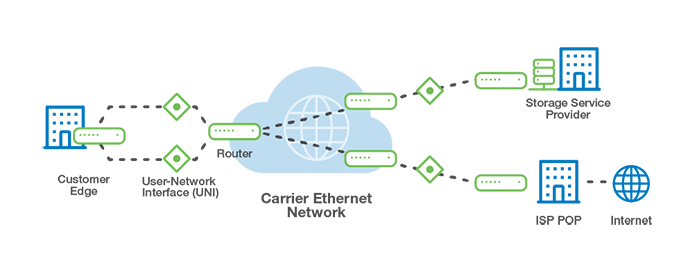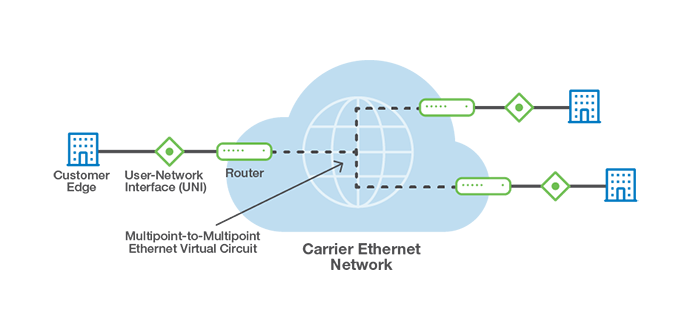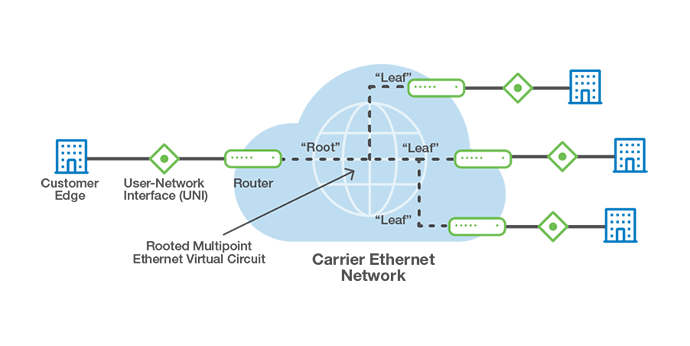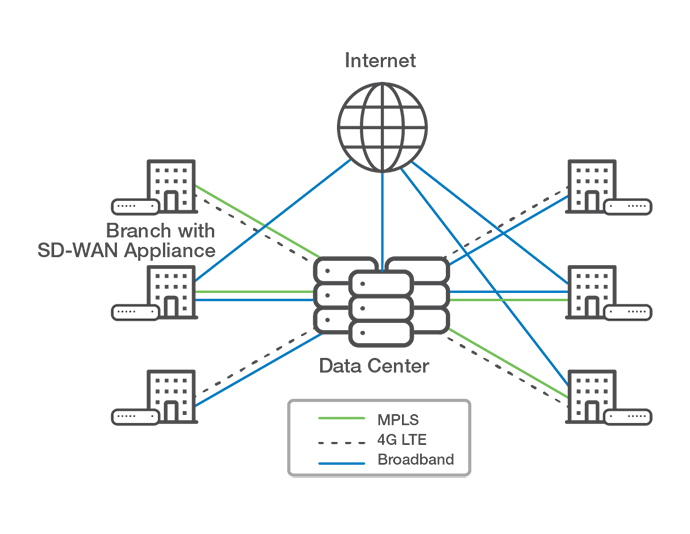What is a Wide Area Network (WAN)?
A wide area network, or WAN, is a computer networking solution that spans a large geographical area, typically connecting different buildings, offices, or sites. Furthermore, a wide area network is a type of computer network that uses the same media (e.g., cable, telephone lines, wireless connections) to provide connections between remote sites that are geographically dispersed, interconnected by communications links linked by various protocols.
WANs have evolved and today are primarily based on a few technologies that can work over fiber, copper or even wireless connections:
What is Multiprotocol Label Switching (MPLS)?
Multiprotocol Label Switching, or MPLS, has powered enterprise networks for more than two decades. An MPLS-based WAN is a virtual private network (VPN) that’s built over the top of a carrier’s MPLS network and sends data packets over Layer 2 (switching) or Layer 3 (routing), avoiding the public Internet.
MPLS supports classes of service (CoS) for different traffic types; traffic prioritization; scalability; control over latency, jitter and packet loss; and the ability to use multiple protocols (e.g., IP, Ethernet, SAN, FDDI) as the name implies. MPLS networks typically are deployed by geographically distributed organizations that need to connect their locations to a data center or headquarters.
Example of an MPLS Network

The Benefits of MPLS
MPLS-based WANs are known for their scalability, performance, efficient bandwidth utilization, reduced network congestion and quality of service (QoS). Because it’s deployed as a VPN, partitioned from the public Internet, it’s also considered a secure transport mode.
That said, MPLS was designed for organizations with geographically dispersed branch offices needing access to enterprise data centers. Today, much of enterprise networking traffic has shifted to cloud providers making MPLS’s hub-and-spoke model less efficient.
For this reason, MPLS is considered a legacy WAN solution and may be displaced or augmented when new IT management pushes for newer network technologies to save the organization money. Larger enterprises, for example, may keep their MPLS networks for legacy apps that run on their enterprise network while offloading Internet traffic and access to cloud apps to a more modern SD-WAN.
Companies in vertical industries like finance may still rely on MPLS to ensure compliance with regulations like Sarbanes-Oxley Act of 20021 and are not eager to replace existing equipment that works.
SMB organizations are more likely to find a better fit with lower-cost Ethernet or SD-WAN options. And those companies that are using an all-cloud IT model are best served by SD-WAN’s all broadband network.
What is Carrier Ethernet?
A more cost-effective alternative to MPLS, Carrier Ethernet extends Ethernet from the LAN to the WAN, enabling companies to connect their Ethernet LANs to carrier networks using the same Ethernet interface, bridging multiple LANs as if they were one network. Carrier Ethernet provides effortless scalability from 10Mbps to 100Gbps so that the network can grow with the business.
Carrier Ethernet operates at Layer 2, the data link layer, and can be configured in a few ways as defined by the Metro Ethernet Forum (MEF):
- Ethernet Private Line (E-Line) — a point-to-point connection between two sites
- Ethernet LAN (E-LAN) — multipoint-to-multipoint, also known as “any-to-any” or “mesh,” network
- Ethernet Tree (E-Tree) — point-to-multipoint, also known as “hub-and-spoke,” network
Carrier Ethernet WANs Come in 3 Configurations
E-Line
Ethernet Private Line (EPL) or Virtual Private Line (EVPL) services are used when businesses have high data traffic between a central hub location, like company headquarters, and a data center or storage service provider.
Example of an Ethernet Virtual Private Line

Ethernet LAN
Ethernet LAN or E-LAN, provides multipoint-to-multipoint connectivity. E-LANs are used when businesses need to connect branch locations or data centers cost-effectively.
Example of an Ethernet LAN Network

Ethernet Tree Network (E-Tree)
An ethernet tree network or E-Tree, provides hub-and-spoke multipoint connectivity and is often used to connect a headquarters or data center to branch offices.
Example of an Ethernet Tree Network

The Benefits of Carrier Ethernet
While MPLS networks have been the top-of-the-line for decades, Carrier Ethernet offers a more cost-effective alternative, especially for SMBs that want to upgrade their networks for improved communications systems, data storage and more.
Carrier Ethernet offers several advantages, including:
Scalability: as your business bandwidth requirements grow, Carrier Ethernet can scale easily without the need for additional onsite equipment.
High Speed: with bandwidth of 10Gbps+ over fiber links, Carrier Ethernet is ideal for businesses looking for high-speed services to connect data centers.
Security: carrier Ethernet operates at Layer 2 and its in-band control channel cannot be accessed via a Layer 3 network, i.e., the Internet, which is in contrast to MPLS routers that can be accessed remotely via the Internet.
QoS: carrier Ethernet VLANs are easily created to separate traffic types, reducing network congestion and latency.
MPLS vs. Ethernet
| MPLS | Ethernet | |
|---|---|---|
| Cost | MPLS typically costs more than Ethernet but less than T1 lines. | Ethernet is typically more affordable than MPLS. |
| Scalability | MPLS can scale to thousands of sites. | Ethernet can scale to hundreds of sites. However, it’s much easier to scale without the addition of equipment. |
| WAN Routing | MPLS allows businesses to leave WAN routing to the service provider and keep fewer WAN engineers on staff. | Ethernet gives WAN engineers control and responsibility over routing. |
| Quality of Service | MPLS has quality of service (QoS) options to enable preferential treatment of latency-sensitive traffic like VoIP. | Network engineers can bypass QoS complexity by hooking switches directly to Ethernet pipes. |
| Service Level Agreements | MPLS services come with service level agreements (SLAs) that include delivery guarantees, unlike consumer broadband. | IT professionals should either ask for an SLA for their Ethernet service or take WAN application delivery into their own hands. |
| WAN Management | Using MPLS for WAN connectivity requires that all network devices and management tools be compatible with both MPLS and Ethernet. | Because LANs use Ethernet, using Ethernet for the WAN gives organizations an all-Ethernet infrastructure, simplifying. |
| Availability | Service providers offer MPLS services in many metropolitan areas but not everywhere. | Ethernet exchanges have made Ethernet WAN services available in more locations. |
What is a Software-defined Wide Area Network (SD-WAN)?
A software-defined wide area network, or SD-WAN, is a more recent addition to the WAN lineup that is groundbreaking in that it leverages low-cost broadband connectivity options and also can replace or integrate with an existing MPLS network.
SD-WAN uses software-defined networking to abstract the control capabilities of underlying hardware on the network into a virtual environment where the network is then managed. Through software, SD-WAN unifies and manages network traffic between the different points on the WAN, including remote branches, data centers and cloud applications.
SD-WAN is ideal for connecting branch offices economically but also can be deployed to affordably provide diverse and redundant low-cost broadband connections at every location.
Example of an SD-WAN Network

The Benefits of SD-WAN
SD-WAN is different from traditional WANs in the way it’s deployed and managed. As its name implies, SD-WAN is a software-driven technology that’s deployed as an overlay or virtualized network. While there are some differences in features depending on the SD-WAN provider, SMBs can expect the following benefits from SD-WAN:
Business Continuity
One of the most valuable benefits of SD-WAN is its ability to deliver network redundancy. SD-WAN can direct traffic on multiple connections, whether the configuration is active or active-passive. This routing ability means that businesses often can avoid network downtime — with their users remaining online and active — even if there is an outage with one or more connections.
Improved Data Security
Often, SD-WAN can support network security by virtualizing a firewall that encrypts public Internet traffic. Some basic security capabilities are inherent with SD-WAN, such as denying or limiting traffic from specific sites. Note: SD-WAN is not a comprehensive security solution on its own and should be paired with other security solutions.
Enhanced Quality of Service (QoS)
SD-WAN steers business critical traffic and applications through the most reliable, highest performing connections. The net impact is a reduction in data packet loss and latency, which improves user experience and productivity.
Have more questions about networking solutions?
We can help! Get in touch with us below to speak to one of our experts.
"*" indicates required fields
